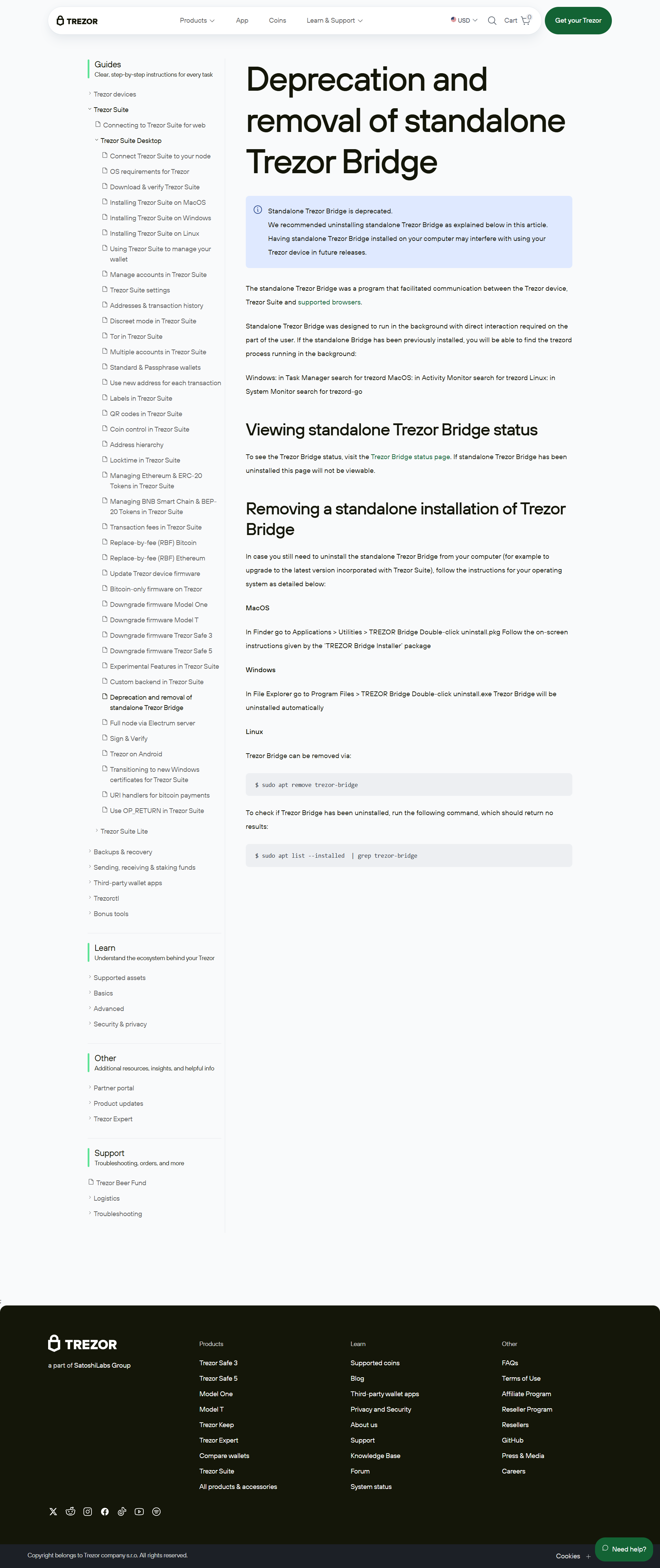Trezor Bridge: The Invisible Backbone of Secure Crypto Management
In the world of cryptocurrency, security, usability, and control are the golden triangle of any good crypto storage strategy. While blockchain promises decentralization and freedom, the way you access your digital assets can make or break your crypto experience. That’s where Trezor Bridge comes into play—a small yet mighty utility that runs silently in the background but makes all the difference in how you interact with your Trezor hardware wallet and browser-based platforms.
This article explores Trezor Bridge in detail: what it is, how it works, why it’s necessary, and how it’s transforming crypto security. Whether you're searching for “how to connect Trezor to browser” or “Trezor not detected in Chrome,” this guide provides a full understanding and offers optimized content for SEO and user engagement.
What Is Trezor Bridge?
At its core, Trezor Bridge is a standalone background service that allows your browser to communicate with your Trezor hardware wallet securely. Developed by SatoshiLabs, this tool replaces the now-deprecated Trezor browser extensions, offering a more robust, compatible, and security-first solution.
When installed, Trezor Bridge facilitates encrypted communication between your Trezor device (Model T or Trezor One) and web applications like Trezor Suite, decentralized finance (DeFi) apps, or third-party services. Without it, your browser simply can't “see” your Trezor wallet.
Why Trezor Bridge Was Created
As cryptocurrency adoption grew, so did the demand for safer and more efficient ways to manage digital assets. Earlier, Trezor used browser extensions—convenient but flawed. These extensions were susceptible to browser updates, sandboxing limitations, and even malicious threats. Users reported errors like “Trezor not found” or “browser extension unsupported.”
Trezor Bridge solved these problems by becoming a system-level utility, not reliant on browsers. It can operate independently across Windows, macOS, and Linux, making it far more versatile, future-proof, and secure.
Key Features of Trezor Bridge (SEO Keywords Included)
Here are the standout features of Trezor Bridge, integrated with long-tail keywords for maximum search visibility:
🔒 1. Secure Browser-to-Wallet Communication
Trezor Bridge communication layer ensures that no sensitive data—like your private keys, PIN, or seed—is ever exposed online. Everything stays securely within your device.
⚙️ 2. Seamless User Experience
Once installed, it automatically runs at system startup. No clicks, no configuration. Users searching for “how to connect Trezor to Trezor Suite” will find Bridge handles it effortlessly.
🌐 3. Multi-Browser Compatibility
Supports Google Chrome, Mozilla Firefox, Brave, and Edge—ideal for people searching “Trezor not detected in Chrome” or “Trezor works with Firefox.”
🧩 4. No Extension Required
Trezor Bridge eliminates the need for browser add-ons. This aligns with SEO phrases like “replace Trezor Chrome extension” or “safe alternative to crypto wallet extensions.”
📤 5. Supports All Trezor Devices
Compatible with both the Trezor Model T and Trezor One, giving users flexibility across different hardware models.
🔄 6. Reliable Updates and Maintenance
Trezor Bridge is regularly updated for compatibility and security, making it a future-proof tool for Web3 interaction.
Installing Trezor Bridge: A Step-by-Step Guide
Users often search for “Trezor Bridge setup” or “how to install Trezor Bridge.” Here’s a fully optimized guide:
✅ Step 1: Visit the Official Download Page
Go to https://trezor.io/bridge. This is the only safe place to download the installer.
✅ Step 2: Choose Your OS
Click the version for your system—Windows, macOS, or Linux.
✅ Step 3: Run the Installer
Follow on-screen prompts. The installer will set Trezor Bridge to auto-start when your computer boots.
✅ Step 4: Connect Your Trezor Wallet
Use the USB cable to connect your Trezor hardware wallet. Open Trezor Suite or a supported web app.
✅ Step 5: You’re Done!
Trezor Bridge will detect your device in the background. You can now send transactions, view balances, and sign data safely.
What Happens Behind the Scenes
Here’s the non-technical explanation users often search for: “How does Trezor Bridge work?”
Trezor Bridge listens on localhost:21325, meaning it runs on your computer only—no external access. When you open Trezor Suite in your browser or on your desktop, the application sends a request to Bridge, which then sends instructions to your Trezor hardware wallet. You review and approve transactions directly on the device screen. At no point are your keys exposed online.
This “loop of trust” is what makes Trezor Bridge such a powerful tool in your crypto security stack.
Common Issues and Fixes (SEO-Targeted Troubleshooting)
Searchers often use queries like “Trezor not working with browser” or “Trezor Suite not detecting device.” Here are some common troubleshooting tips:
❗ Bridge Not Running?
Ensure that Trezor Bridge is running in the background. Restart your computer or reinstall the software.
❗ USB Connection Problem?
Try a different USB port or cable. Not all cables support data transfer.
❗ Conflicting Software?
Disable antivirus temporarily and allow permissions if your firewall is blocking the Bridge port.
❗ Outdated Version?
Always keep your Bridge updated via https://trezor.io/bridge.
Use Cases: Why You Need Trezor Bridge
If you want to manage your crypto assets securely while interacting with modern Web3 platforms, Trezor Bridge is essential. Here’s how it fits into daily use:
💼 Crypto Portfolio Management
Use Trezor Bridge with Trezor Suite to manage Bitcoin, Ethereum, stablecoins, and thousands of ERC-20 tokens—all with your keys safely offline.
🖋️ Transaction Signing
Send and receive crypto with full transparency. Review all transaction details on your hardware screen before confirming.
🔗 Accessing dApps and Web3 Tools
Interact with decentralized platforms like Uniswap, Aave, or MetaMask using Trezor as the signing key via Bridge.
📦 NFT Management
Securely store and view your NFTs while ensuring the signing process happens offline and safely.
🔐 Password Management
Combine Trezor with Trezor Password Manager, protected via Trezor Bridge, for encrypted password storage.
Made in Typedream
